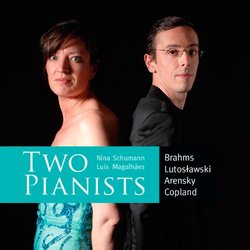| All Artists: Nina Schumann;Luis Magalhaes Title: TwoPianists Play Brahms, Arensky, Lutoslawski & Copland Members Wishing: 0 Total Copies: 0 Label: TwoPianists Original Release Date: 1/1/2010 Re-Release Date: 6/6/2009 Album Type: Single Genre: Classical Style: Chamber Music Number of Discs: 1 SwapaCD Credits: 1 UPC: 6009801039022 |
Search - Nina Schumann;Luis Magalhaes :: TwoPianists Play Brahms, Arensky, Lutoslawski & Copland
 | Nina Schumann;Luis Magalhaes TwoPianists Play Brahms, Arensky, Lutoslawski & Copland Genre: Classical
Historically, most distinguished performers of classical music travelled beyond their home to pursue mastery of their respective instruments in Europe or the United States. Some left for short periods before they returned ... more » |
Larger Image |
CD Details
Synopsis
Product Description
Historically, most distinguished performers of classical music travelled beyond their home to pursue mastery of their respective instruments in Europe or the United States. Some left for short periods before they returned to make significant musical contributions in the country of their birth. Others remained abroad for extensive periods, spanning their entire performing careers, before returning home to retire. Yet others settled in their adopted countries where their talents were rewarded with opportunities and recognition not readily forthcoming in their home country. In what is a rich historical tapestry of musical migration, intercontinental transmission of performing practices and kaleidoscopic influences, there is very little precedent for South African-Portuguese exchange. The Magalhaes-Schumann Piano Duo (TwoPianists), institutionally based at Stellenbosch University, is therefore cultural history in the making. Luis Magalhaes was born in Lousado in Portugal, and grew up in its environs. He started playing the piano at the age of five and received tuition from Eduardo Rocha, Jose Alexandre Reis, Pedro Burmeister and Vladimir Viardo, as well as masterclasses from, amongst others, Paul Badura-Skoda and Alicia de Larrocha. By the time he went to study piano at the University of North Texas in 1999, Magalhaes was already a seasoned recitalist, concerto and chamber music performer. He had also won several prizes at national and international competitions. It was at North Texas where he met his Duo-partner, Nina Schumann, at the beginning of 1999. Resident in Los Angeles before then, she had come to study with Viardo at the University of North Texas in 1996 after having met him during masterclasses in South Africa in 1995. Previously she had studied with Lamar Crowson and Vitaly Margulis, winning every major South African competition and scholarship and establishing herself locally as one of the most promising musicians of her generation. At the beginning of 1999 Schumann was appointed Associate Professor in piano at Stellenbosch University, and she started commuting between North Texas and the town of her birth. The result of mutual professional admiration and personal attraction in equal measure, the Magalhaes-Schumann Piano Duo was founded in that same year. It soon achieved international recognition, with performances across the USA, Germany, South Africa, Portugal, Austria, Switzerland, Japan being praised for their display of synchronicity and technical prowess, expressive feeling and insight. To be sure, the character of this artistic collaboration is determined by a receptive empathy between two very different pianists. Playful charm intermingles with fastidious realization of text, delicate accuracy with impressively sonorous sound, percussive brilliance with meticulously formed singing lines. This is evident on their recording of Rachmaninoff s complete works for two pianos. Tempting as it is to describe this fusion culturally as one between an old world steeped in tradition and a new world vibrantly responsive, the comparison doesn t work aesthetically. What is evident from the enthusiastic reception of Magalhaes-Schumann performances, however, is that the forging of such a broad register of pianistic ability from two contrasting styles results in a sound and interpretative depth of sumptuous richness. And because music is never divorced from worldly circumstance, the fascination of this artistic dialogue must surely also derive in part from the Magalhaes-Schumann marriage, and the universally recognizable spark that ignited and continues to sustain it.

 Track Listings (40) - Disc #1
Track Listings (40) - Disc #1